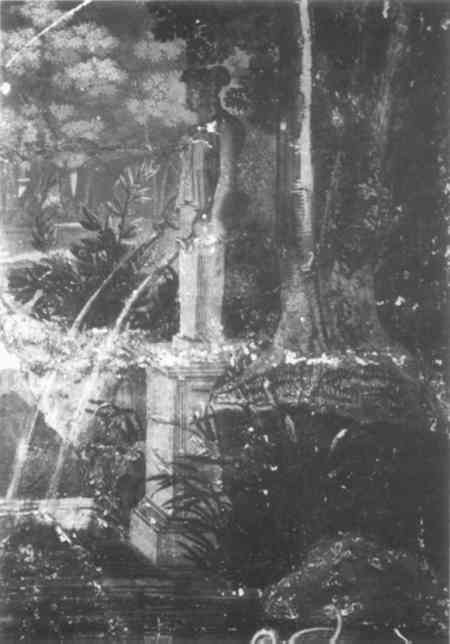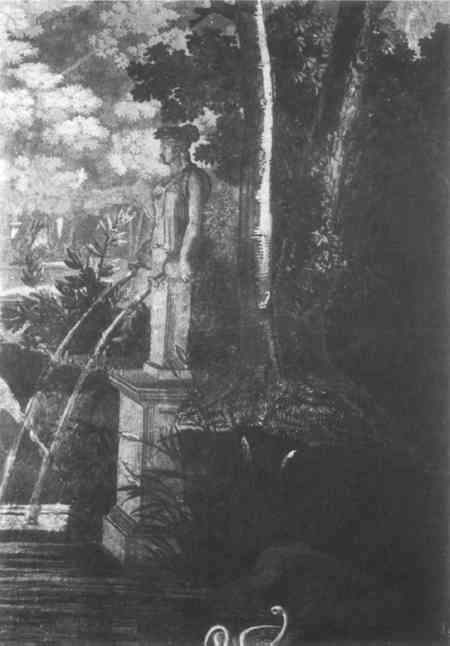THE IN-SITU CONSERVATION TREATMENT OF A NINETEENTH-CENTURY FRENCH SCENIC WALLPAPER: LES PAYSAGES DE T�L�MAQUE DANS L'ILE DE CALYPSODoris A. Hamburg
5 TREATMENTThe treatment involved several main steps which might be broadly categorized as cleaning, consolidation, filling and inpainting. Paper and canvas which covered cracks in the plaster were peeled back to expose the crack and lightly secured with masking tape. In some areas it was necessary to cut carefully through the paper and canvas to reveal the entire crack. A professional plasterer repaired the wall cracks. Thereafter the canvas, secondary support and original paper were readhered using wheat starch/methyl cellulose paste with thymol fungicide. In some areas a small amount of poly (vinyl acetate) emulsion Jade 4039 was added to the paste for extra strength. Cleaning followed. Loose surface dirt was minimal except in a few areas which were lightly cleaned using a soft brush. Testing revealed that only the poster-paint variety of overpaint could be removed safely from the wallpaper and this had to be accomplished before consolidation of the paint. Gentle rolling with cotton swabs dipped in distilled water, to which a fractional percentage of wetting agent10 had been added, removed much of this paint. Parts of the original design that the overpaint had hidden became evident. In many areas, however, removal of the restoration paint revealed large areas of abrasion in which no original paint remained. The West Wall continuous roll paper was more reactive to water than the earlier vintage East Wall paper. More tenacious paint had to be left on the West Wall rather than endanger the original paint and primary support. The West Wall was also swabbed with heptane, an organic solvent, to remove surface grime and aid later penetration of the consolidants.
Consolidation proceeded in two steps. First the water sensitive paint layers were relaxed and lightly reattached to the paper by the application of a solution of 2% methyl cellulose in distilled water. This was applied with one-inch watercolor brushes. On the East Wall the application was followed by a soft three-inch brayer rolled over paper towelling against the wall to absorb the excess moisture and to apply gentle pressure. It was found that this process cleaned the paper somewhat as evidenced by the dirt on the paper towels and a generally brightened appearance. On the West Wall it proved unsatisfactory to roll over the paint through the towelling due to a higher reactivity to water and weak adhesion between wallpaper and paint. Paint flakes would adhere to the towel, however gently it was applied. Thus in order to remove excess methyl cellulose from the West Wall, each area upon drying was gently swabbed with cotton dipped in 1:1 ethanol/distilled water. At this point, a second adhesive, 5% v/v poly (vinyl acetate) resin AYAA in toluene was applied by brush overall, with the exception of the sky, to provide a stronger bond and to counteract the effects of humidity. Due to the toxicity of toluene the application was done in the evening, when visitors and staff had gone home. Fans were in operation and the conservators wore respirator masks. During the second summer, ethanol was available as the solvent for PVA AYAA, which reduced the toxicity problem. In some areas the use of low heat, provided by a tacking iron through silicon release paper, aided adhesion in severely flaking areas, as did a second coat of PVA AYAA in other sections. In the sky portion of the design it was noted that some color intensification resulted from application of PVA AYAA. Therefore during the first summer, the sky was consolidated only with methyl cellulose. Re-examination of the sky section during the second summer indicated, however, that consolidation with only methyl cellulose was insufficient. Also, that area was extremely difficult to inpaint due to its continued reactivity to water. Further testing showed that after consolidation with the AYAA the hue and intensity better approximated other areas of original paint and blended more satisfactorily with the blue paper border above the sky. After curatorial and conservation discussion, it was decided to consolidate the sky throughout the wallpaper, brush-coating it with the 5% v/v poly (vinyl acetate) resin AYAA. To attach cleaving paper, wheat starch/methyl cellulose paste was introduced with a syringe or brush as appropriate. The paper was then held in place briefly or rolled over with a brayer on a paper towel. Losses in the primary support paper, where inpainting would be required, were filled with Permalife acid-free bond paper attached with the wheat starch/methyl cellulose paste. Inpainting was the most time-consuming aspect of the treatment. A cosmetic procedure, the inpainting was geared to the general restoration of the original design. An essential aid in evaluating the images was a set of color photographs of another example of the Telemachus wallpaper. The wallpaper used as a reference is in excellent condition.11 The colors of the reference set, as shown in the photos, were somewhat different from those at the Hermitage, so inpainting colors were determined through a comparison of related areas of the original on the Hermitage wallpaper. Liquitex acrylic polymer emulsion paints were used to inpaint the areas of
Working on site involved logistical considerations in planning the treatment; throughout both summers of the conservation work visitors continued to tour the central hallway as it was the only access to the parlor and the main staircase. Scaffold and equipment added to the disruption. Via a poster, guides' explanations and personal conversations, a concerted effort was made to thwart the myriad conclusions arrived at by the visitors regarding the unfamiliar activity in the central hallway. The scale of such a wallpaper project must not be underestimated; by the completion of the treatment the more than 580 square feet of wallpaper had been covered seven different times, rarely using any tool larger than a one-inch brush. |



